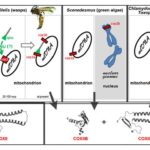
The majority of protein-coding genes in nuclear genomes are interrupted by spliceosomal introns or, less often, by inteins. These intervening sequences are spliced at the RNA or protein level, respectively, so that intact proteins become reconstituted. In